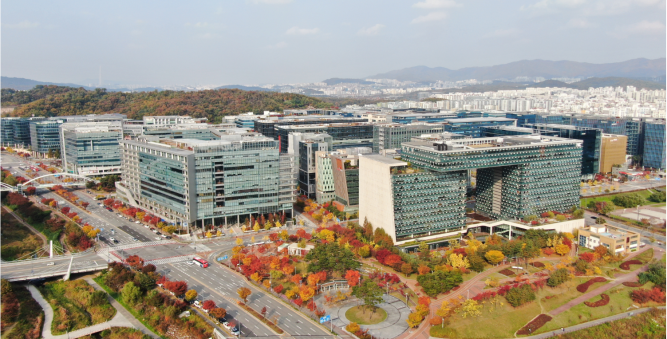Just south of Seoul, in the city of Seongnam, sits what many call the Silicon Valley of South Korea. This is the sprawling tech complex known as Pangyo Techno Valley. It is just a 15-minute subway ride from Gangnam, an area better known for its luxury boutiques, K-pop agencies, and neon nightlife in Seoul.
Since its launch in 2011, the 661,000-square-meter development has evolved into one of the country’s most significant innovation hubs. It is home to more than 1,800 startups, research centers, and global tech firms, all packed into a district that feels more like a laboratory for South Korea’s future than a suburb of Seoul.
Big names are everywhere in Pangyo Techno Valley. These include Naver, often described as Korea’s Google, and Kakao, the country’s everything-app. Gaming powerhouses Nexon and NCSoft anchor the district alongside industrial heavyweights like shipbuilder HD Hyundai and cybersecurity pioneer AhnLab. Samsung Electronics, semiconductor giant SK Hynix, and Hyundai’s autonomous vehicle division 42dot all maintain significant presences.
Despite this concentration of tech talent and capital, industry insiders question whether Pangyo truly deserves its Silicon Valley comparison. Hyoungchul Choi, CEO of Portologics, who founded his company there five years ago, acknowledges Pangyo is absolutely Korea’s most concentrated hub for software, gaming, platforms, and AI. But he is skeptical of the Silicon Valley label. He says the nickname is convenient, but we should not overstate its global influence. He explains that Silicon Valley is not just about density. It is built on decades of international capital flows, a risk-taking culture, and its ability to attract talent worldwide. He believes they are not there yet.
The statistics back up this more modest assessment. As of a year ago, Pangyo Techno Valley was predominantly home to smaller players. Approximately 91.5 percent of its companies were small and mid-size businesses. Big tech accounted for just 3.6 percent, with the remaining 4.9 percent made up of public or government organizations.
Janice Sa, a principal at Z Venture Capital who has been working in Pangyo for more than a decade, sees the district’s influence waning. She says that with giants like Kakao, Naver, Nexon, and NCSoft all in one place, the title of Korea’s Silicon Valley still makes sense. But compared to ten years ago, the district does not feel quite as dominant as the country’s go-to tech hub. She recalls that back then, startups were flocking to Pangyo. Today, many are heading back to Gangnam in Seoul. The reasons, she added, boil down to talent and capital. Young developers and engineers still gravitate toward Gangnam, and most venture capital firms are packed along Teheran Street, the city’s main tech corridor lined with startups, big tech offices, and investors. For hiring and fundraising, that makes Gangnam the easier choice.
This exodus reflects a broader challenge. For big corporations tied to long-term leases with tax incentives, being in Pangyo is not much of an issue. But for startups competing for talent, the location can be a greater challenge. Pangyo might be only a short ride from Gangnam, but it is still in Gyeonggi Province, not Seoul. Because government support programs are often tied to local jurisdictions, Seoul ends up with more active startup infrastructure and stronger global initiatives.
An insider at a Pangyo-based tech firm, who asked not to be named, shared a similar perspective. With so many tech companies in one place, Pangyo has developed a culture that feels naturally geared toward the industry. He said that when you are working in tech here, collaboration comes easier because everyone is just around the corner. But he noted that Seoul is more diverse. For example, Yeouido is Korea’s Wall Street, perfect for fintechs, while Gangnam draws startups of every kind.
The bigger question is whether Korean startups, regardless of location, can compete globally. Both government and private investors are pushing companies to expand internationally as the domestic market saturates. Yet breakthrough success stories remain elusive.
A Kakao Ventures investor highlights cultural differences that may explain the gap. American startups tend to succeed and fail much faster, which fuels constant experimentation and a high rate of talent movement. Speed is a startup’s greatest strength, so this investor tries to have open conversations with founders about how to turn failure into opportunity.
Storytelling is another challenge, says this investor. Many Korean founders are sharp on numbers and strategy, but stumble on a simpler question: What is your story? Business is still about people connecting with people. Without a clear, authentic narrative of why you and your team are the right ones, it is hard to stand out. Because so many already bring strong skills to the table, that personal story becomes even more important.
Hyoungchul Choi sees reason for optimism despite the challenges. The scene blends the grit of scrappy founders with the steady influence of big Korean tech companies, where stability and benefits still matter. Unlike in the U.S., where founders often leap into risk and pivot fast, startups here tend to balance ambition with discipline, building proof at home before going abroad. The outcome is dependable engineering, but without the same move fast, break things energy that defines Silicon Valley.
Pangyo is also moving beyond gaming and platforms into AI, biotech, and deep tech, with governments investing in startup campuses and scaling programs, Choi observed.
The real test now is less about local growth and more about proving global success through unicorns, cross-border exits, and steady inflows of talent, he said. What holds Korean startups back from going global? Three key factors are the small size of the home market, weaker global investor ties, and language or regulatory hurdles that create additional friction. Breaking through takes more than ambition; it needs early global partners, deliberate go-to-market resources, and leaders who think cross-border from day one.
Yet a fourth factor, their ability to tell compelling stories to the world, may also prove to be the biggest difference between remaining a regional tech hub and becoming a true global innovation center.

